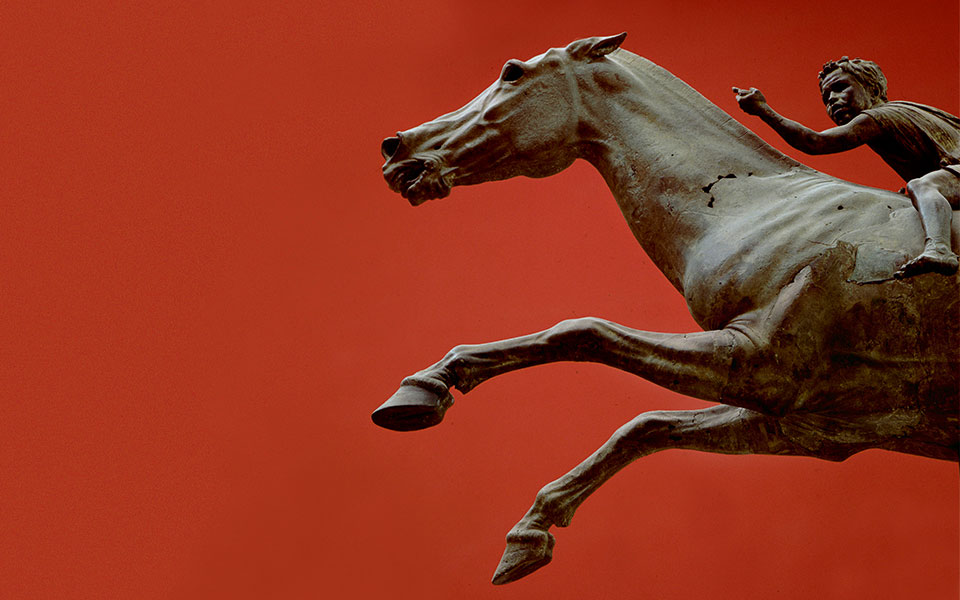Stories Told by the Stones of Crete
A forgotten world comes to life...

Part of the Odyssey exhibition at NAM
Myth says that the head of Orpheus floated down the Evros River and across the sea before being found by humans, who built a shrine for him. In the Odyssey, the islands and the sea provide the story with ten years’ worth of adventures. In real life, historically and to this day, the Mediterranean Sea has played just as an important role for the Greeks.
The seabed has many times been proven to be a rich repository of historical artifacts. Thankfully, sometimes things resurface. When sponge divers got stuck at the island of Antikythira due to bad weather in 1900, they decided to make use of their time and dive right there. Rather than coming back up with just sponges, they also retrieved samples from what they described as a horror scene of human and animal bodies; in fact, they were sculptures from an ancient shipwreck.

The Artemision Jockey
Many artefacts, such as the Antikythira Mechanism (1st or 2nd c. BC), known as the world’s oldest analog computer, were recovered during the next year, before the site was abandoned for 75 years as a result of a diver dying.
The story is similar at the site of the Artemision wreck, where divers found the famous Artemision Jockey and his horse (ca 140 BC), and the impressive statue of Zeus or Poseidon known as the Artemision Bronze (ca about 450 BC), in 1926. The wreck was abandoned after a diver died just two years later. The sea gives, and the sea takes away.
These and hundreds more treasures that have been salvaged from the sea can be admired at the National Archeological Museum in Athens. Last year the museum celebrated its 150 year anniversary with the exhibition “Odysseys”, featuring many of the famous artefacts from wrecks and islands that have been in its protection since their discovery, as well as items on loan from other museums.
The temporary exhibition, which was due to end last October, proved to be a major hit, increasing visitor numbers to one of Athens’ most important museums by 24%. In response to the overwhelming interest, the authorities decided to extend the exhibition to March 24th 2018.

The Antikythira Mechanism is known as the worlds oldest analog computer.

Statue of Aphrodite, Pan and Eros at the Odyssey exhibition.
© Paulina Kapsalis
On our visit, arranged by Be a Greek, the professional guide Theodora Rapti points out that sometimes catastrophes are what save the memory of a place and time. When palaces burned, so did the clay discs people used to write on in Mycenaean times – hardening them and turning them into a permanent records lasting thousands of years. They are now a primary source of information about the first known Greek syllabic script. Shipwrecks can have a similar silver lining. While the time in the sea certainly deformed or completely ruined many of the artefacts on the ships, the inaccessibility of the wrecks kept them away from the hands of plunderers, and the destructive forces of wars, earthquakes and fires.
Today, of course, excavations are a lot less risky, and sites are easier to explore. Some of the archeologists’ latest achievements at the wreck off Antikythira is creating a map of the site, determining the original placements of the finds. And there is still plenty to be uncovered when excavations resume in the spring.
On the one hand, one might be drawn to the romantic thought that (the marble statue of) Odysseus (first half of 1st c. BC) might have spent an eternity in the Mediterranean Sea, had it not also been discovered at the Antikythira wreck by those sponge divers in 1900. On the other hand, these finds are often what provide us with insight about how the ancient Greeks moved, where they went, and why. They are also amazing to see with your own eyes.
The Odysseys exhibition will be on display until March and the museum (www.namuseum.gr) is open Monday 13.00-20.00 and Tuesday-Sunday 09.00-16.00. Entrance is 5 euro. Be a Greek (www.beagreek.com) also organizes custom tours around Athens, in English, Greek, Italian, French, and Portugese.
A forgotten world comes to life...
Discoveries along Amalias Avenue, from the...
From temples and festivals to front...
In Syntagma Square, marble, flame, and...